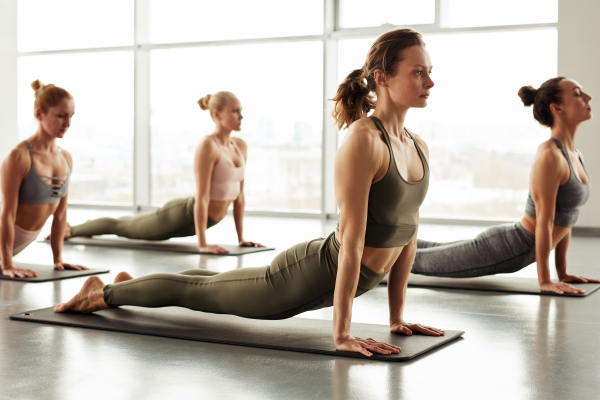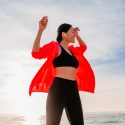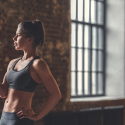Flow Yoga: The Key to Balance and Energy. Basic Practice of 9 Asanas
 Flow yoga, known as "in the flow," can be practiced by both beginners and experienced athletes. This style, which emerged in the 1920s, has become fundamental for many yogis. What sets it apart from other types of yoga? Why should you give it a try? We will explain the theory and guide you through your first practice.
Flow yoga, known as "in the flow," can be practiced by both beginners and experienced athletes. This style, which emerged in the 1920s, has become fundamental for many yogis. What sets it apart from other types of yoga? Why should you give it a try? We will explain the theory and guide you through your first practice.Essence and Benefits
This style has gained immense popularity today. Through these sessions, you achieve both relaxation and an energy boost for the entire day. Flexibility, strength, and endurance are developed while working on breathing. The health benefits become apparent rather quickly.
Training helps maintain the musculoskeletal system in good shape. Twisting in some asanas can have a gentle therapeutic effect on the spine. Bends and arches reduce fat deposits and stimulate the digestive system. Standing asanas help alleviate rheumatic pains, improve joint mobility, and strengthen ligaments and muscles. Practicing flow yoga enhances overall physical endurance and attractiveness, and your mood will undoubtedly improve after each session.
Flow yoga aims to warm up the body, enhance blood circulation, increase sweating, and accelerate lymphatic movement. This helps to relieve tension, reduce swelling, and lower the risk of injury, even during intense workouts.
The practice consists of smoothly transitioning poses. Often, movements change with each inhale-exhale cycle, allowing you to enter a state of flow and train mindful body awareness. Synchronizing movement and breath is crucial during asanas.
Contraindications
Although yoga is a relatively gentle form of exercise with few contraindications, some do exist. It is not recommended for individuals with hypertension, musculoskeletal disorders, or respiratory or circulatory system problems. Post-surgery or after severe illnesses, it is advisable to wait before practicing. Pregnant women and those who have recently given birth should opt for specialized yoga complexes designed for them.
Flow Yoga in Practice
Beginner classes progress from simple to complex, focusing primarily on balance. The practice follows a wave-like pattern: increasing intensity followed by complete relaxation, emphasizing the unlocking of the body's hidden resources. No one will ask beginners to perform complex asanas initially. Experienced teachers will consider your level of preparedness.
At the start, limit your sessions to 45-60 minutes. We will outline a sequence of nine asanas. Each pose flows into the next and is performed on both the right and left sides. Ensure your breathing is synchronized with your movements.
Tadasana
Stand straight, with arms along your body, palms facing in. Feet should be together.
Straighten your shoulders, look forward. Your body should form a vertical line from heels to the crown.
Reach upwards with the crown. Breathe deeply through your nose.
Perform several breathing cycles.
Uttanasana
Exhale and slowly bend forward with a straight back by hinging at the hips.
Extend your head toward the floor. Place your palms on the floor beside your feet.
Deepen the bend with each exhale.
Perform several breathing cycles.
Chaturanga Dandasana
Step back with both feet.
Transition to a plank pose on extended arms, with palms under shoulders. Feet on toes. Keep your back straight.
Avoid rounding or arching your back. Extend your head forward.
On an exhale, bend your elbows to a 90-degree angle, keeping elbows close to your body, legs straight.
Perform several breathing cycles.
Urdhva Mukha Svanasana (Upward-Facing Dog)
From the previous pose, push your torso forward on an inhale. Spread your fingers wide and press palms firmly into the floor. Feet should rest on the floor.
Lengthen your back and open your shoulders. Reach upwards with the crown, push your shoulders down, and avoid straining your neck.
Continue to push through your palms, feeling the extension in your arms and the opening of your chest. Hips off the floor. Feet pressed down.
Perform several breathing cycles.
Adho Mukha Svanasana (Downward-Facing Dog)
Place your feet on the floor. Hands shoulder-width apart, fingers forward, pressed firmly into the floor.
On an inhale, lift your hips up, reaching your tailbone toward the ceiling. Relax your head and neck.
Try to straighten your knees without lifting your feet off the floor.
Perform several breathing cycles.
Virabhadrasana 1 (Warrior I)
On an inhale, step forward with your right foot, bending your knee. The angle between your thigh and shin should be 90 degrees or slightly more. Hips facing forward.
Extend your left leg and place it on the toes. Lift your torso up, arms extended overhead alongside your ears.
Perform several breathing cycles.
Virabhadrasana 2 (Warrior II)
From Warrior I, turn your hips to the left, extend your arms to the sides, and gaze over your right hand.
Keep the angle between your right thigh and shin at 90 degrees. Left foot pressed down, leg straight. Left foot on the floor.
Perform several breathing cycles.
Utthita Trikonasana (Extended Triangle Pose)
On an exhale, straighten both legs and turn your left foot inward at a 30-45 degree angle.
Keep your arms parallel to the floor and, reaching forward with your right arm, begin to lower towards your right leg.
Place your right hand on the rise of your right foot.
Extend your left arm upwards, forming a line with your right arm. Look up at your left hand.
Perform several breathing cycles.
Parivrtta Trikonasana (Revolved Triangle Pose)
Without changing your leg position, turn your torso to the right, changing the position of your body and arms.
Place your left hand on your right shin and extend your right arm upwards. Look at your right hand.
Keep your knees straight and your right foot grounded. The outer part of your left foot should be firmly on the floor.
Perform several breathing cycles.
On an inhale, bend your right knee and return to Warrior I. Step your left foot forward and repeat the sequence of the last four asanas on the left leg.
Staying healthy and emotionally stable is a challenging task in today’s fast-paced world. However, by tuning into yourself and aiding your body, you will be one step closer to physical and mental equilibrium.









